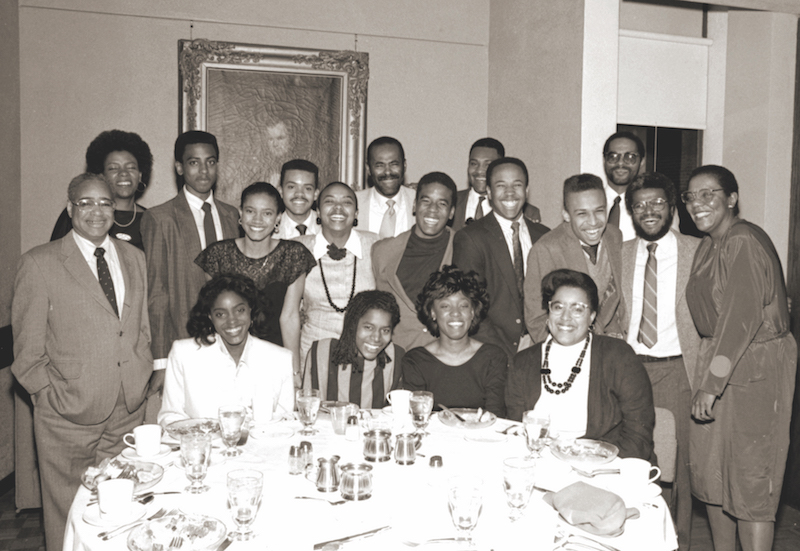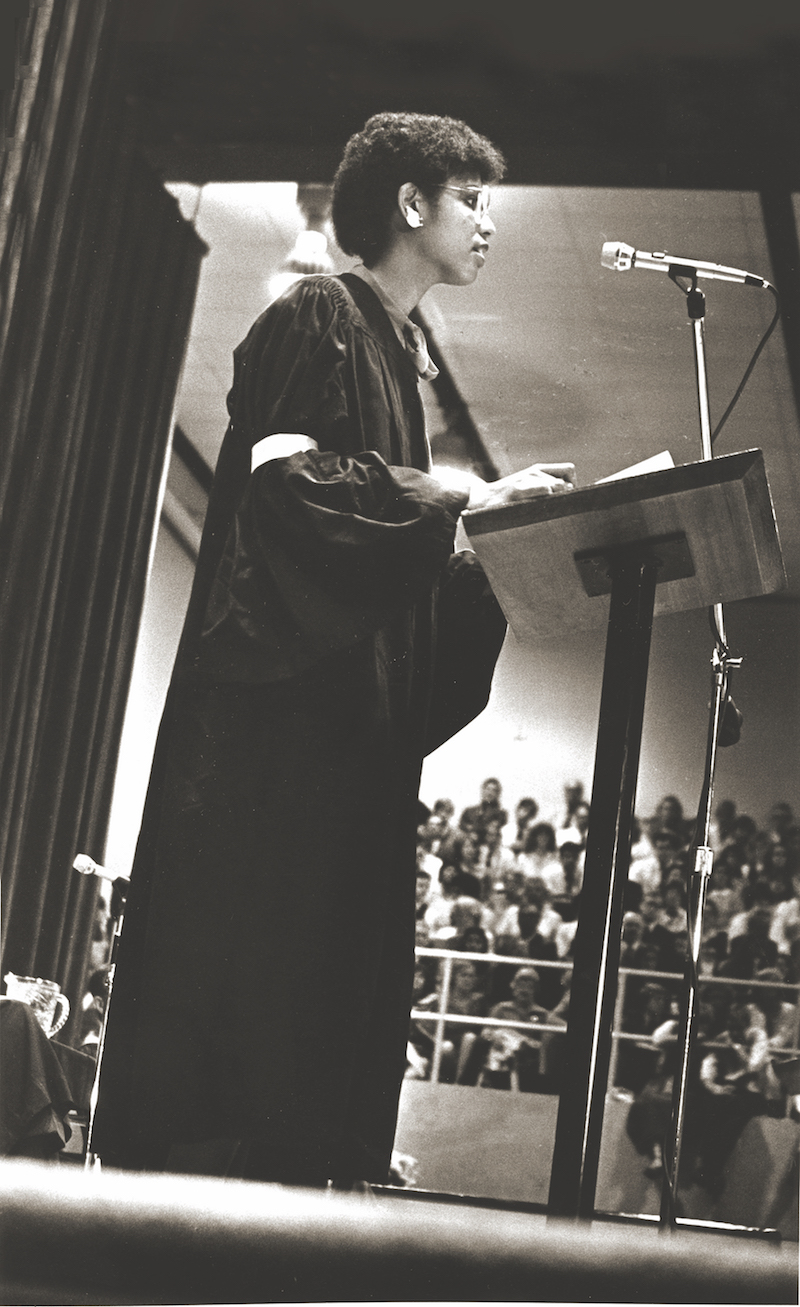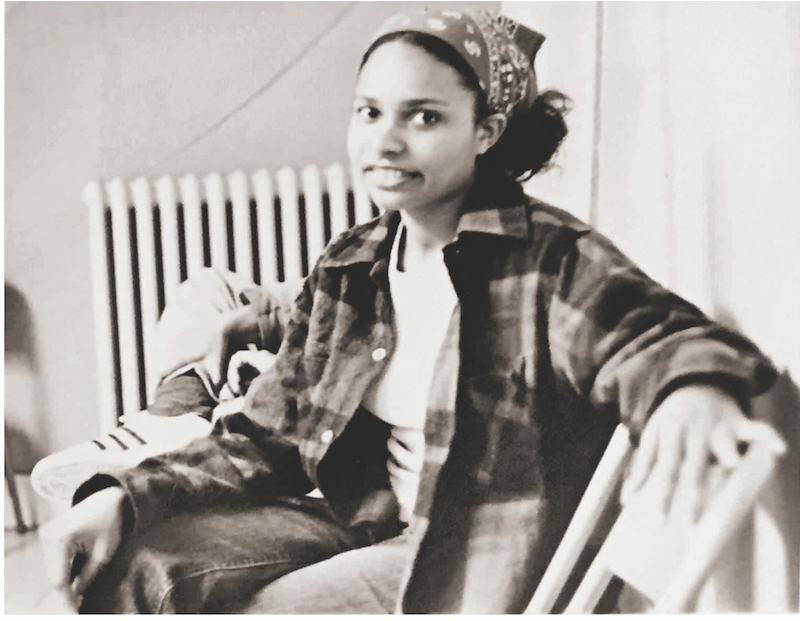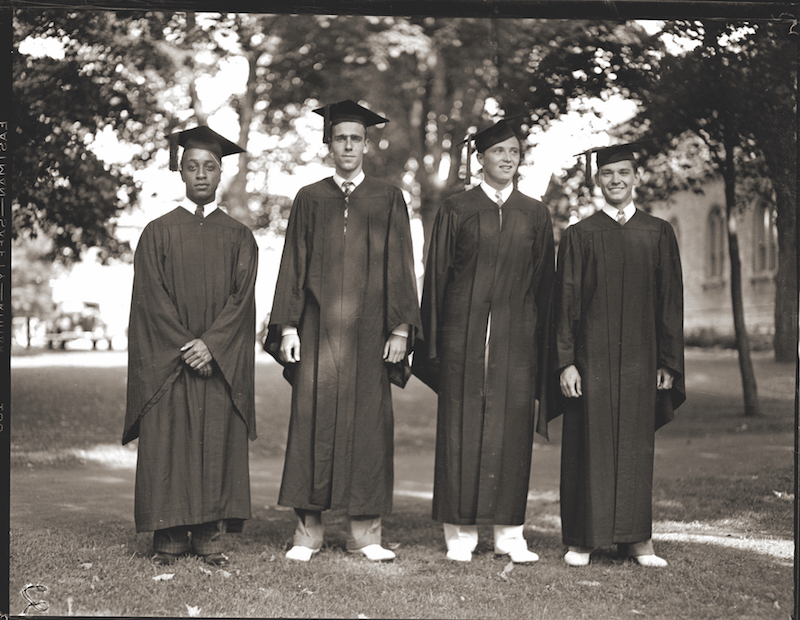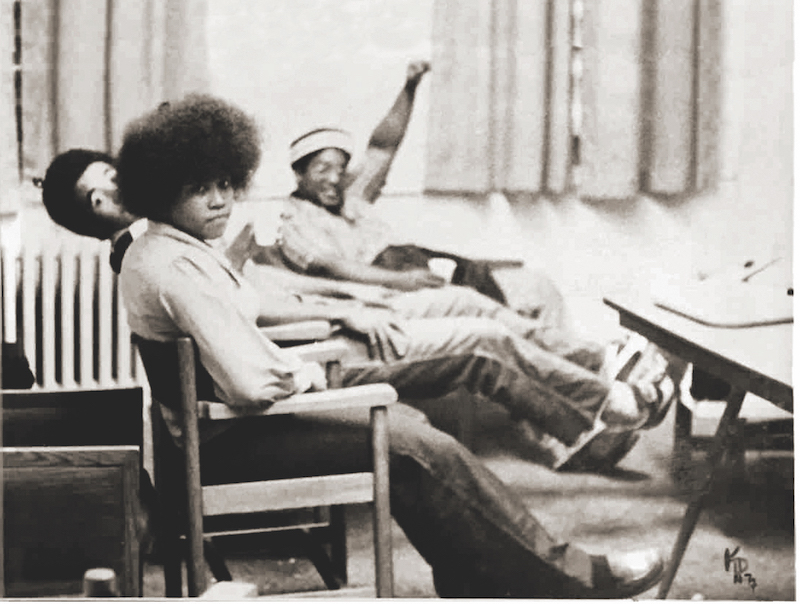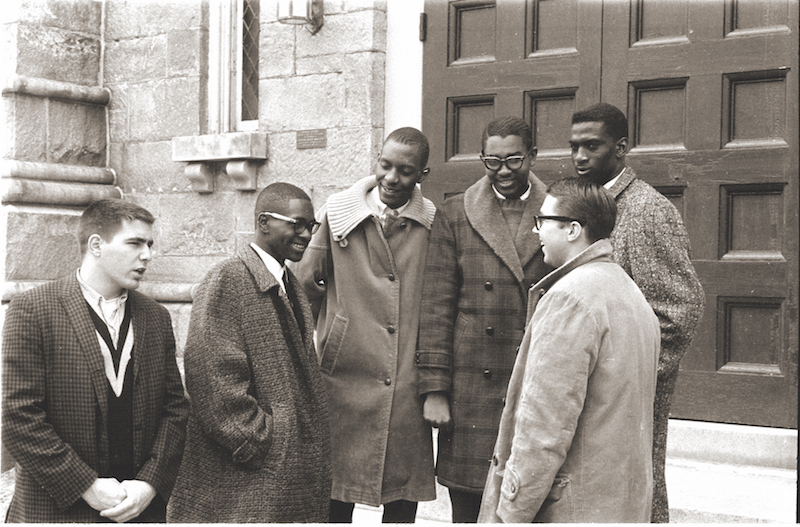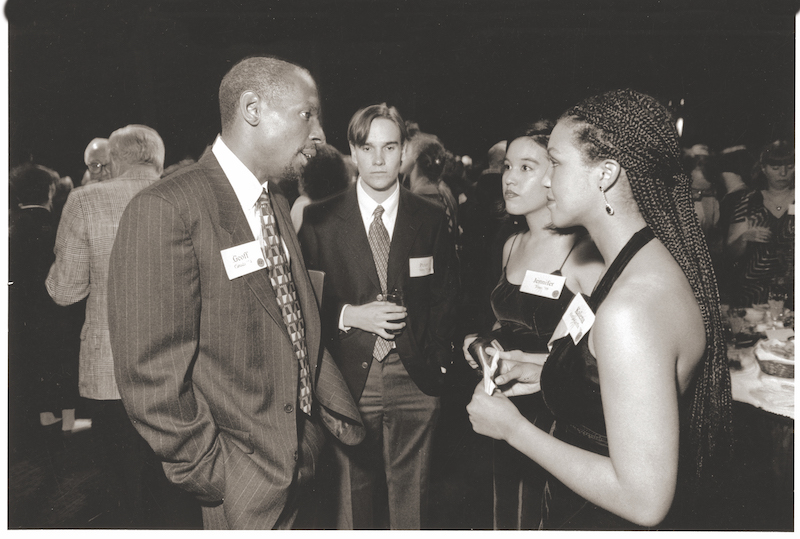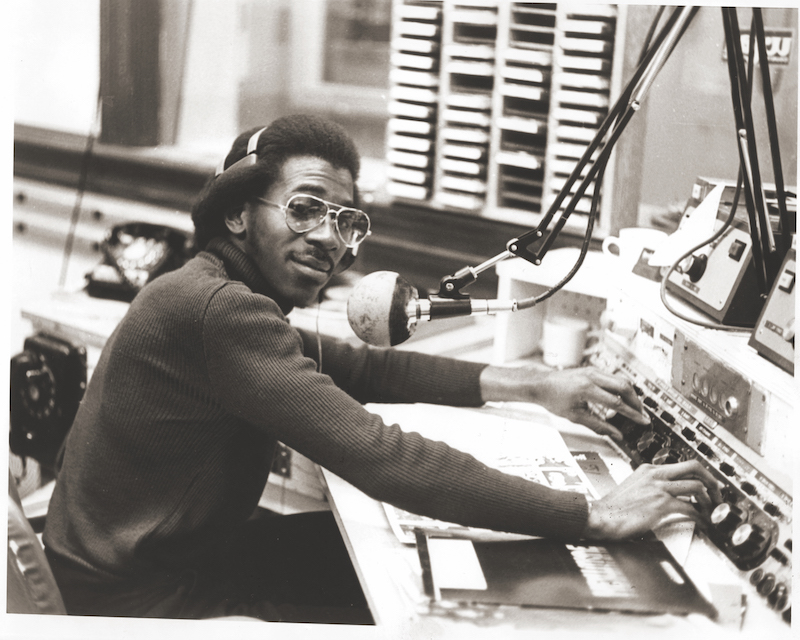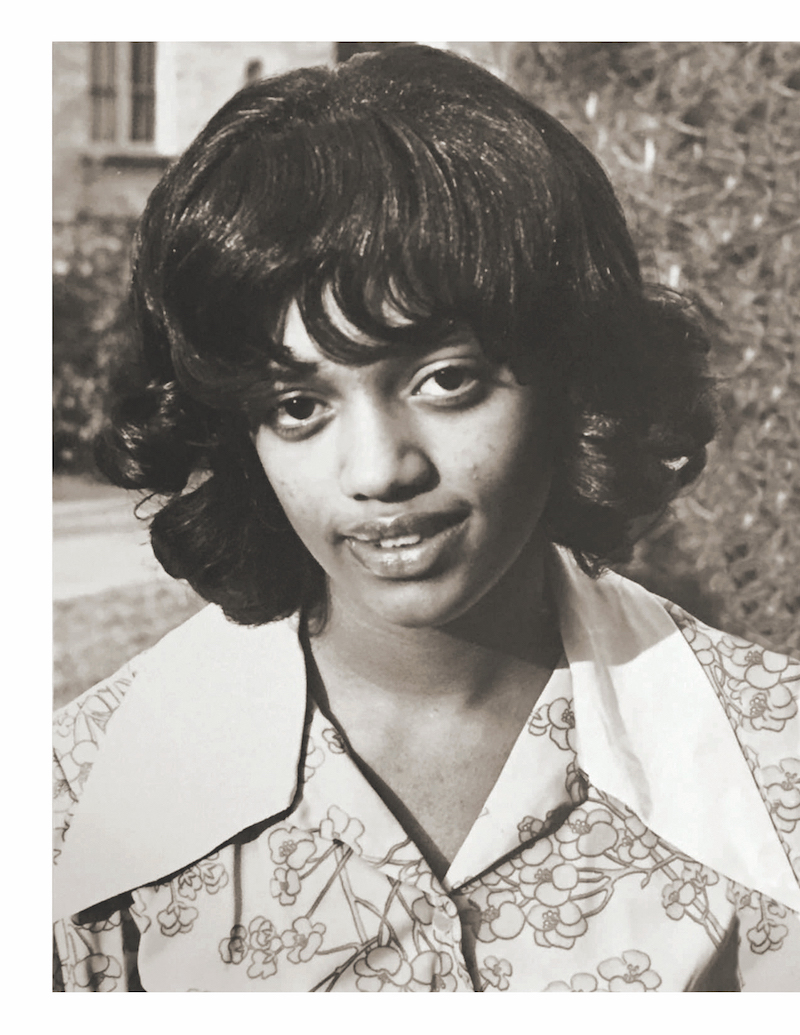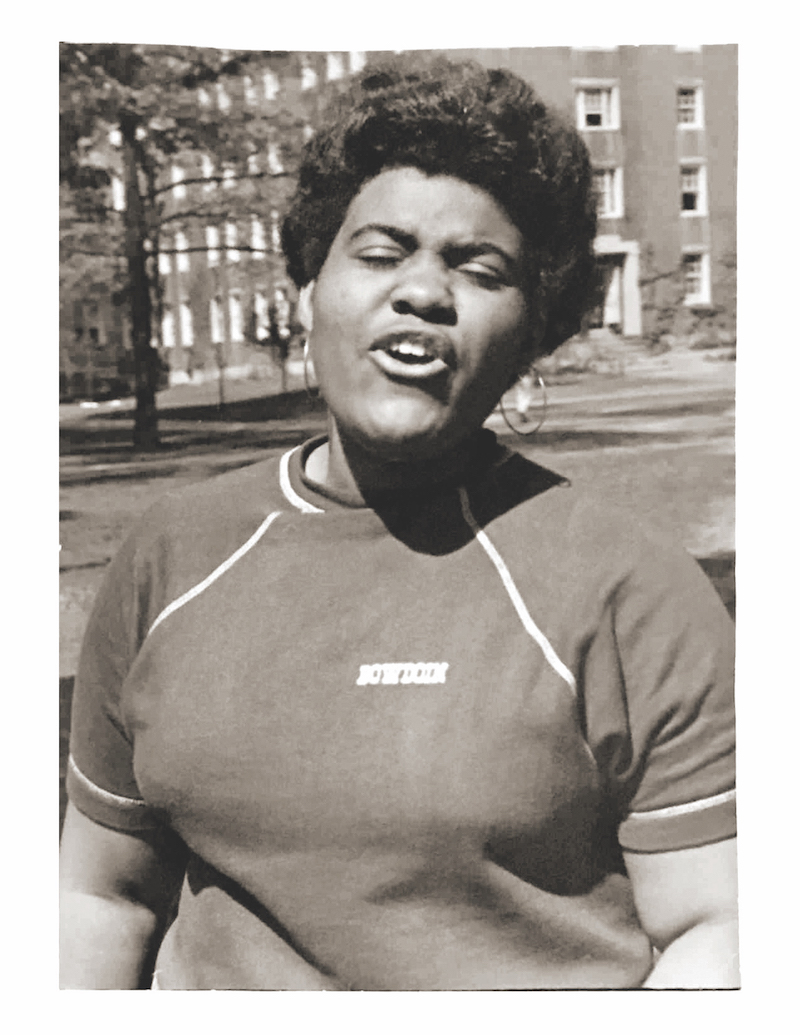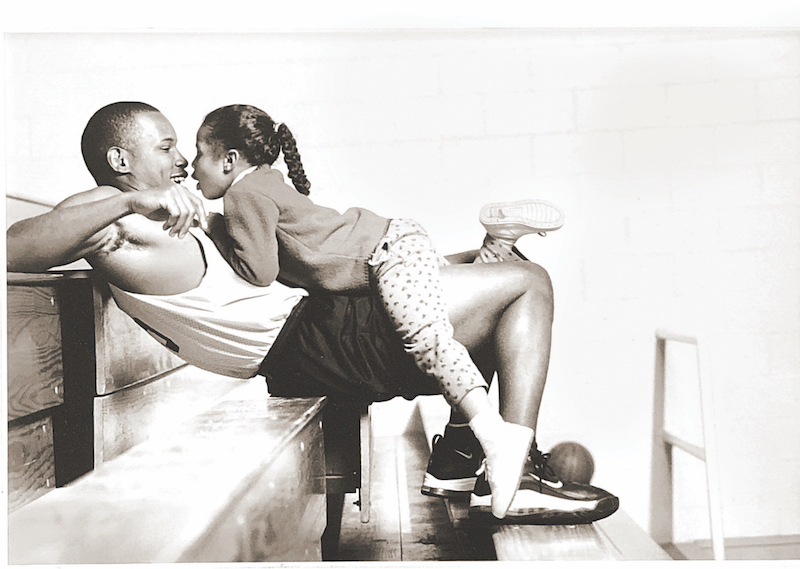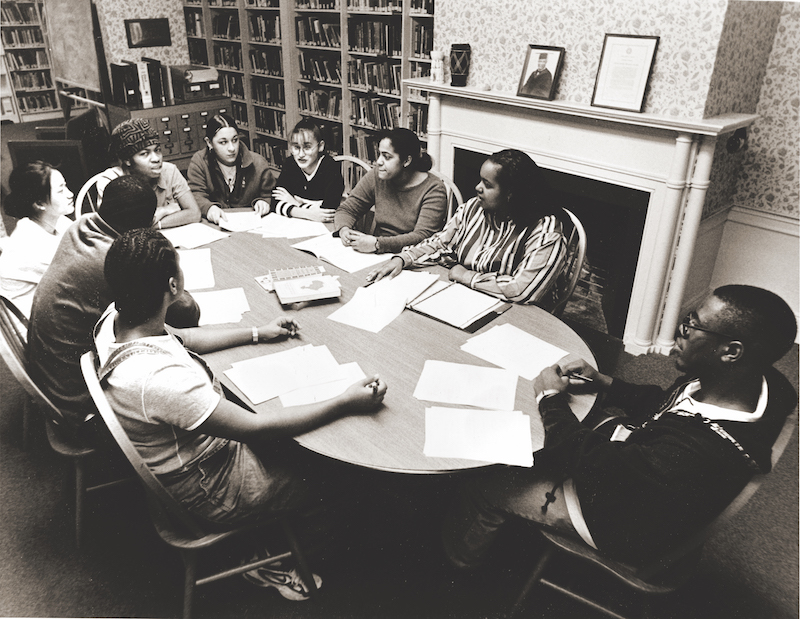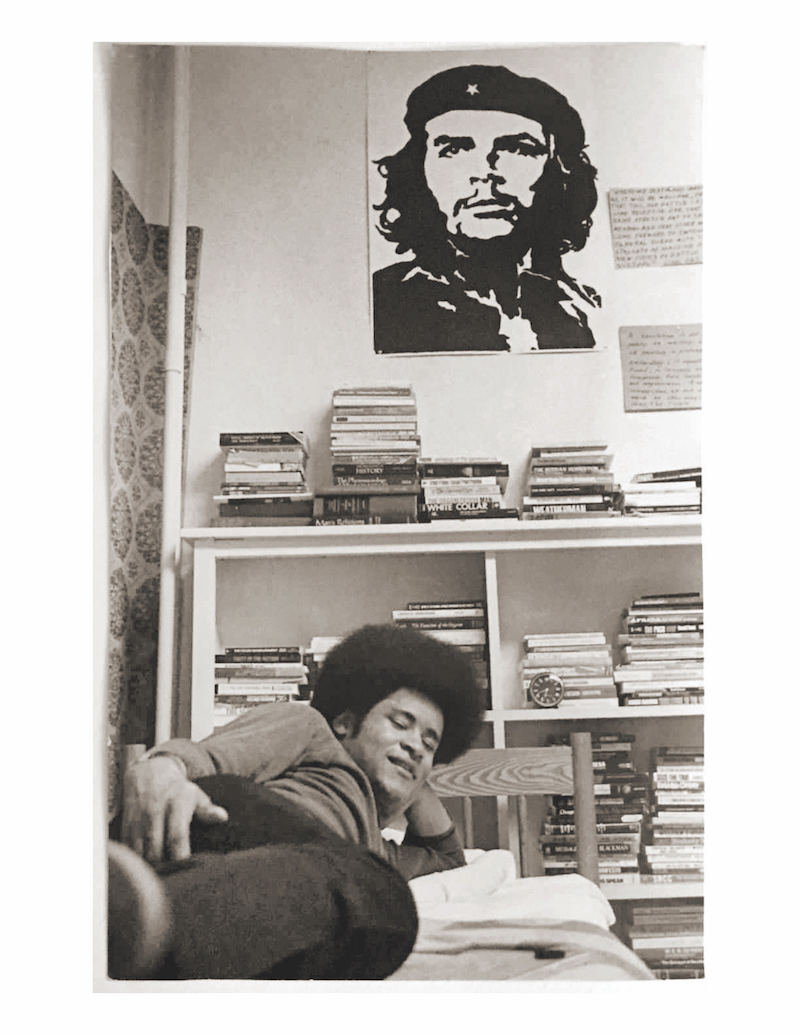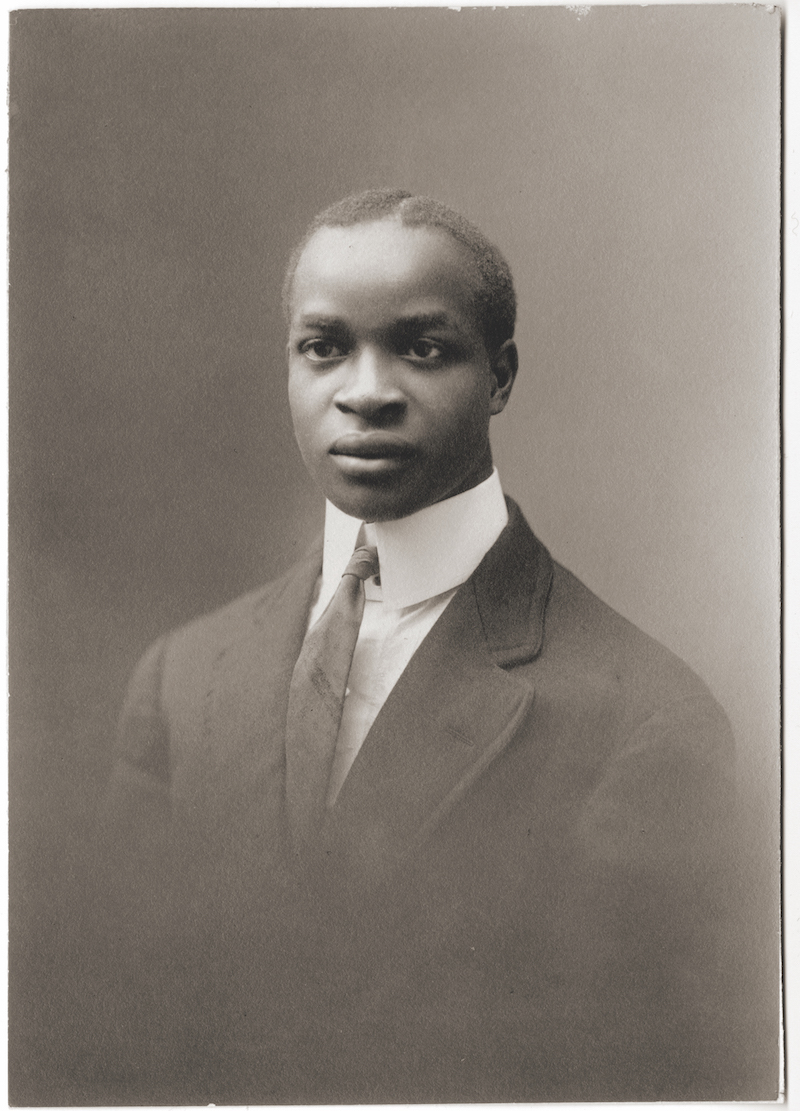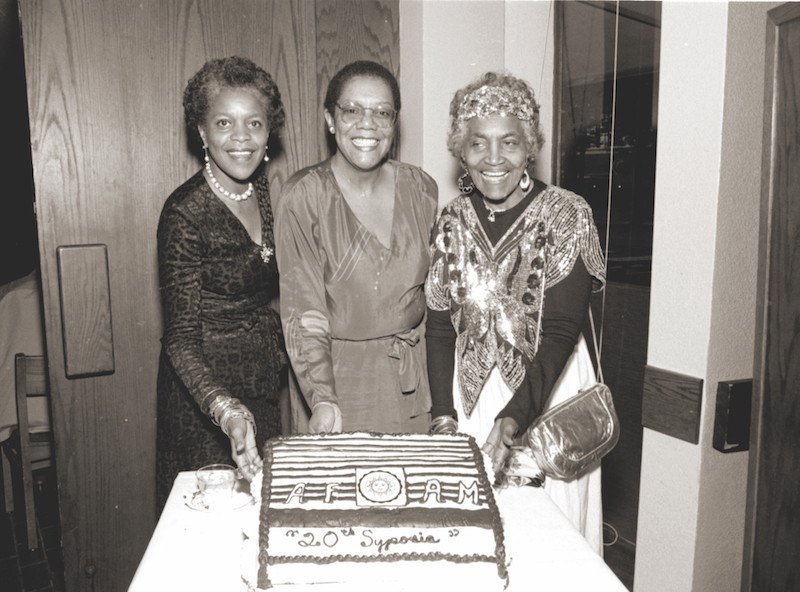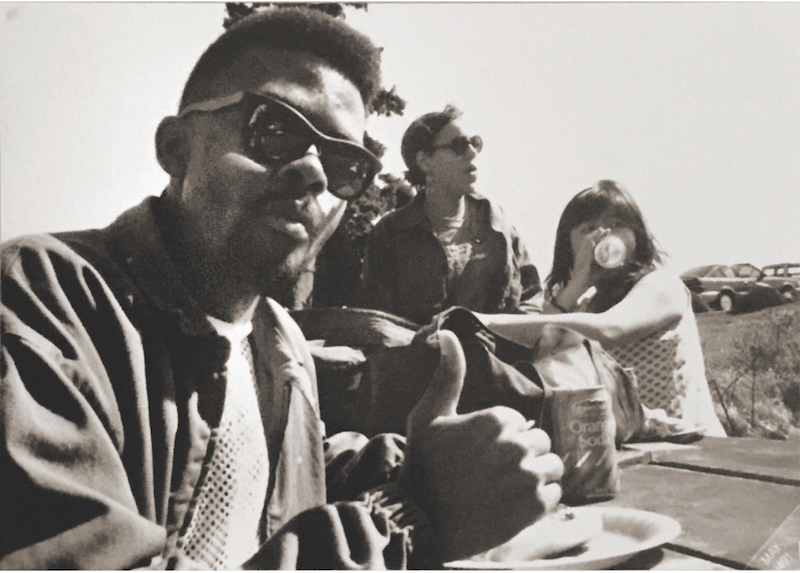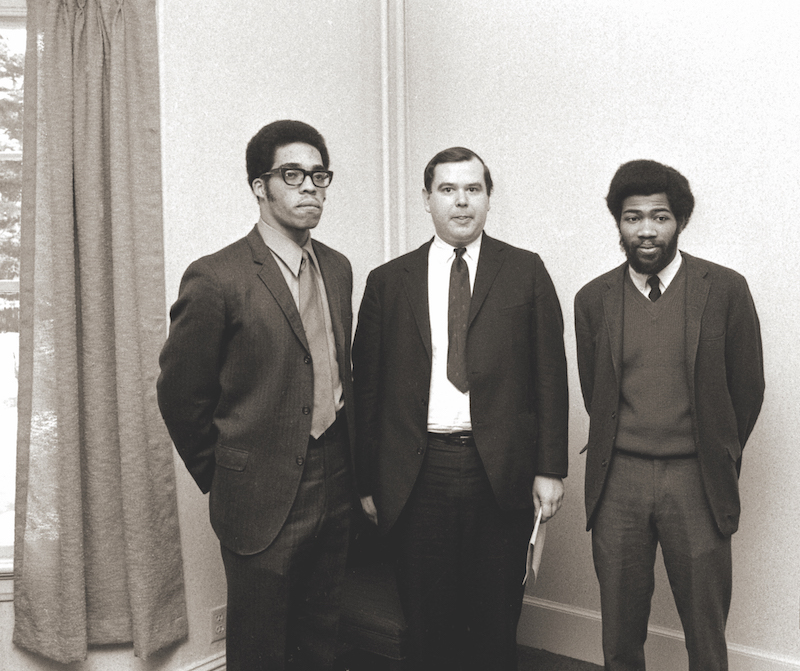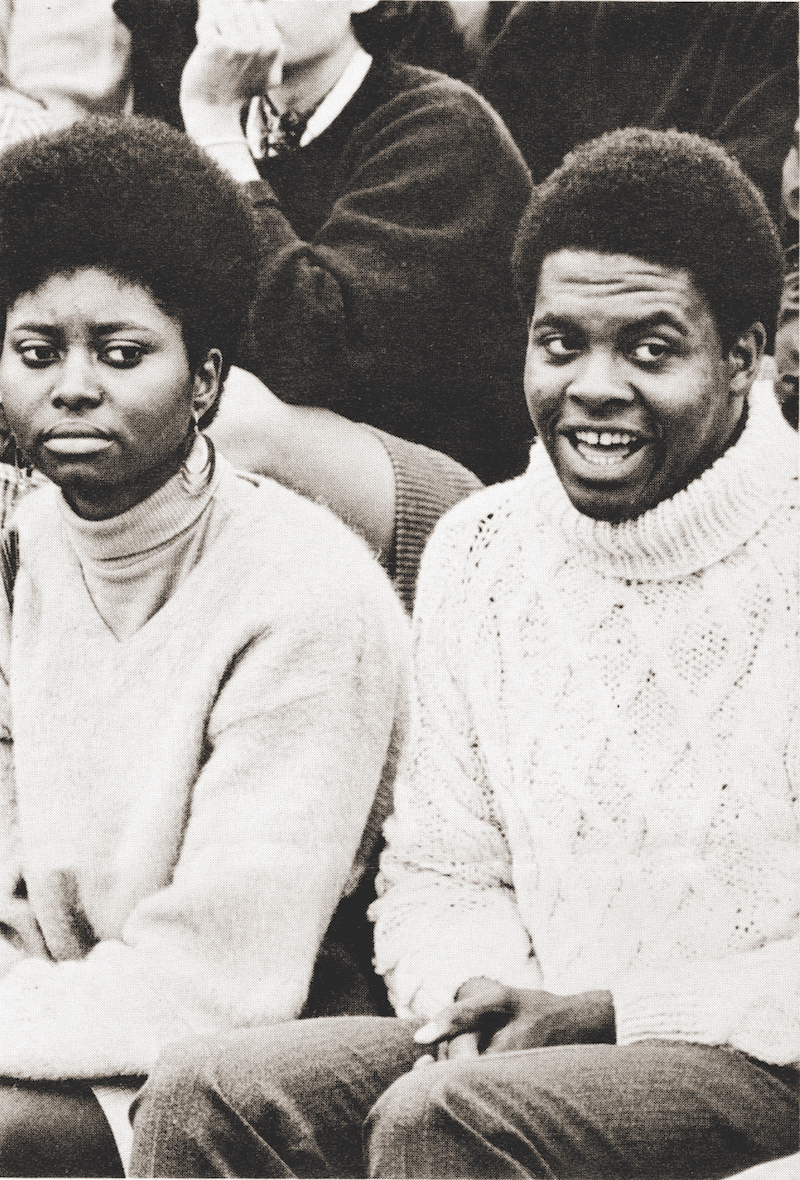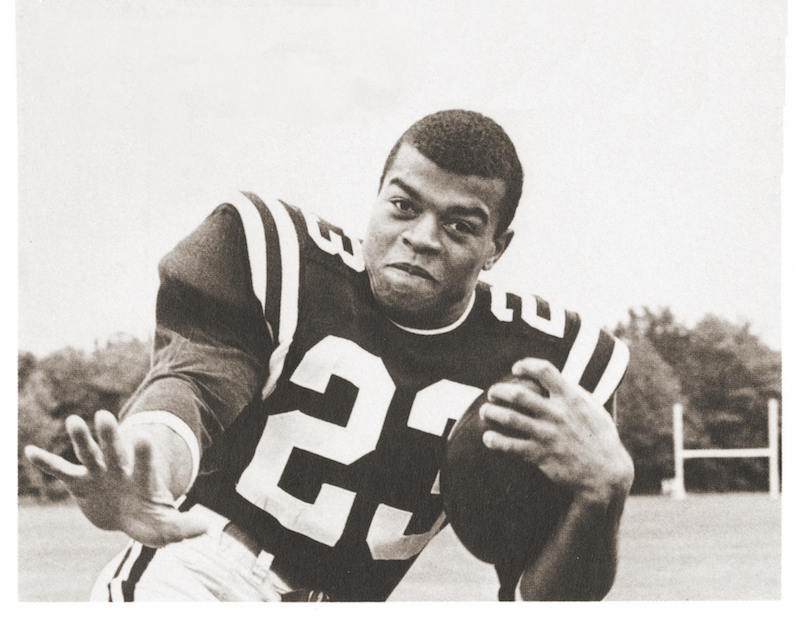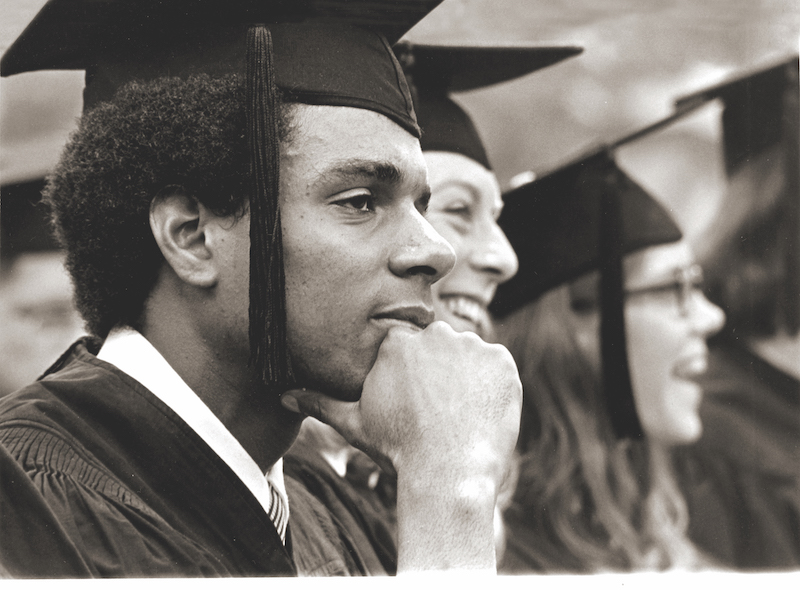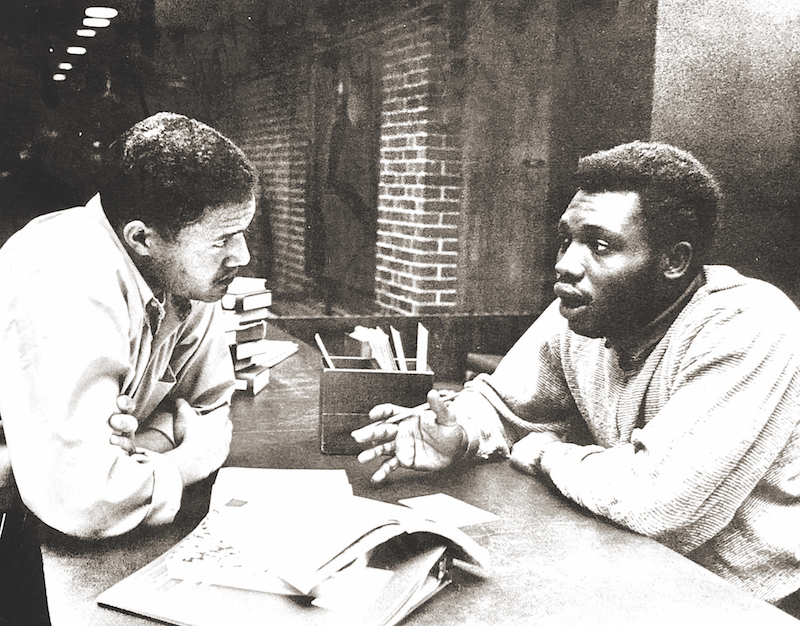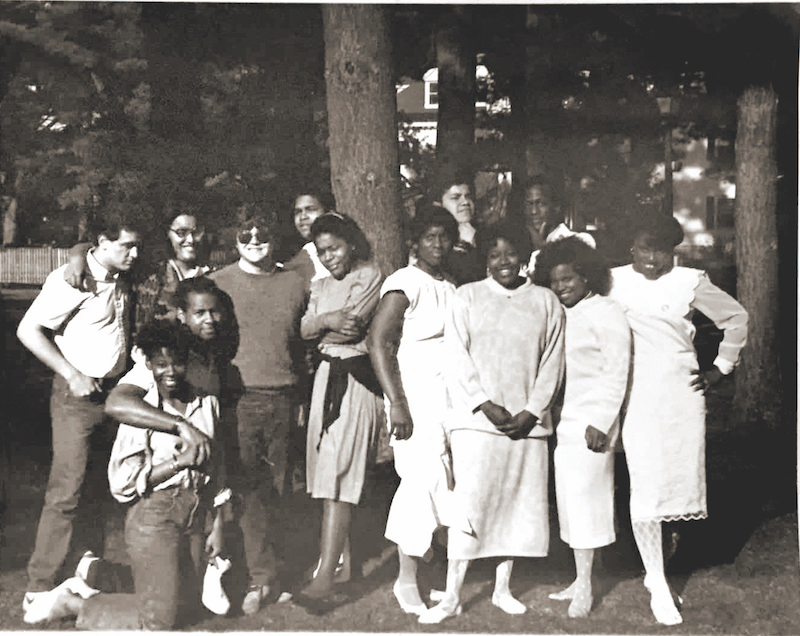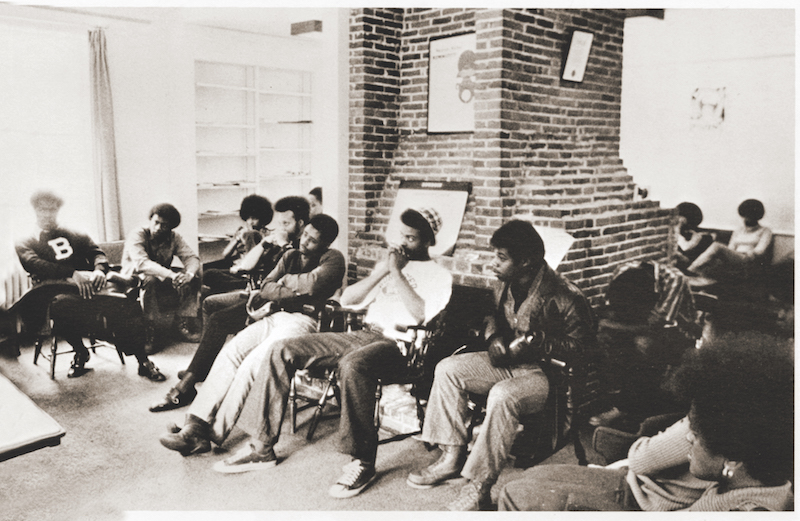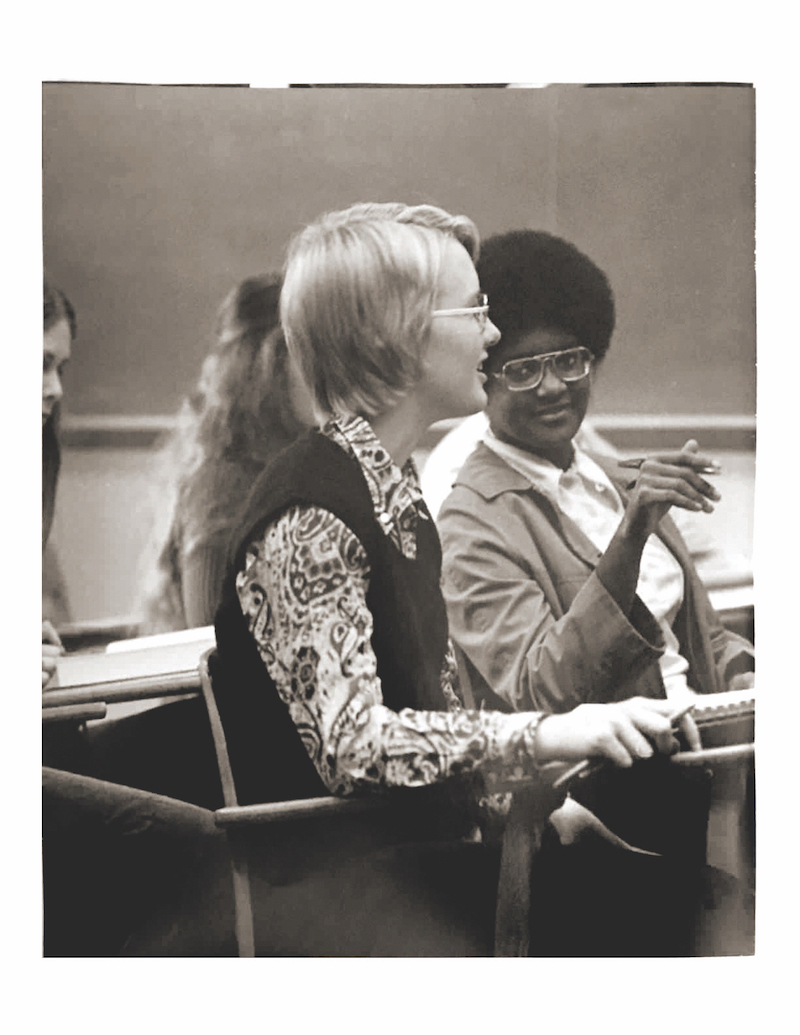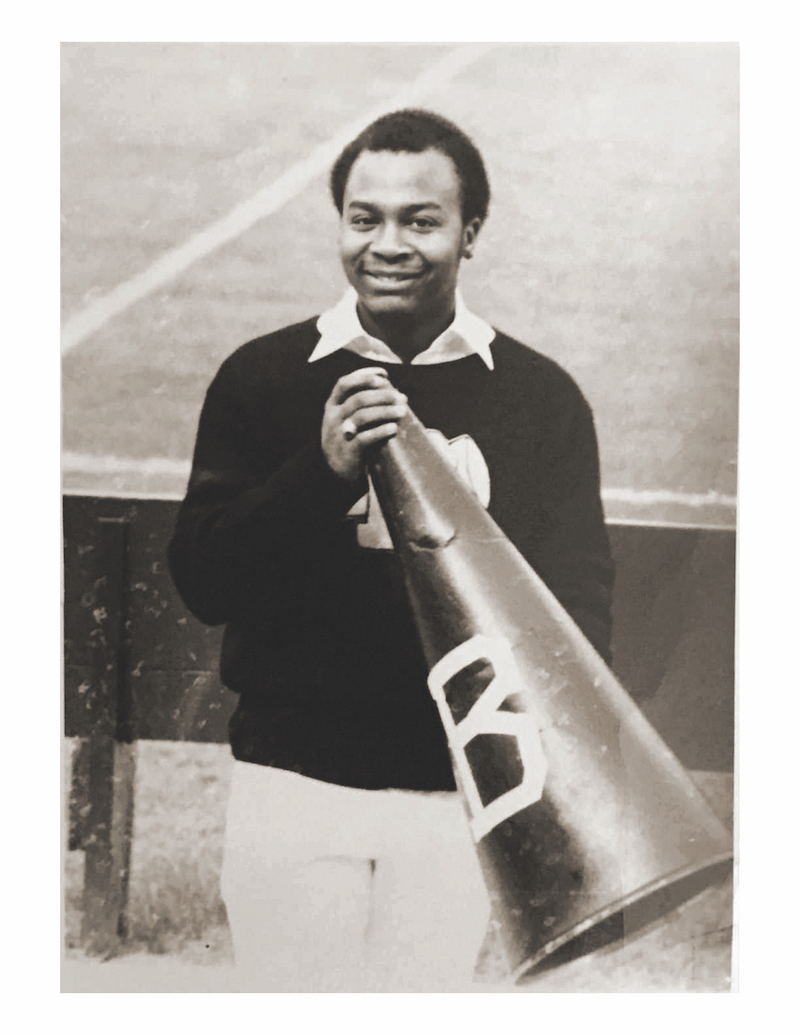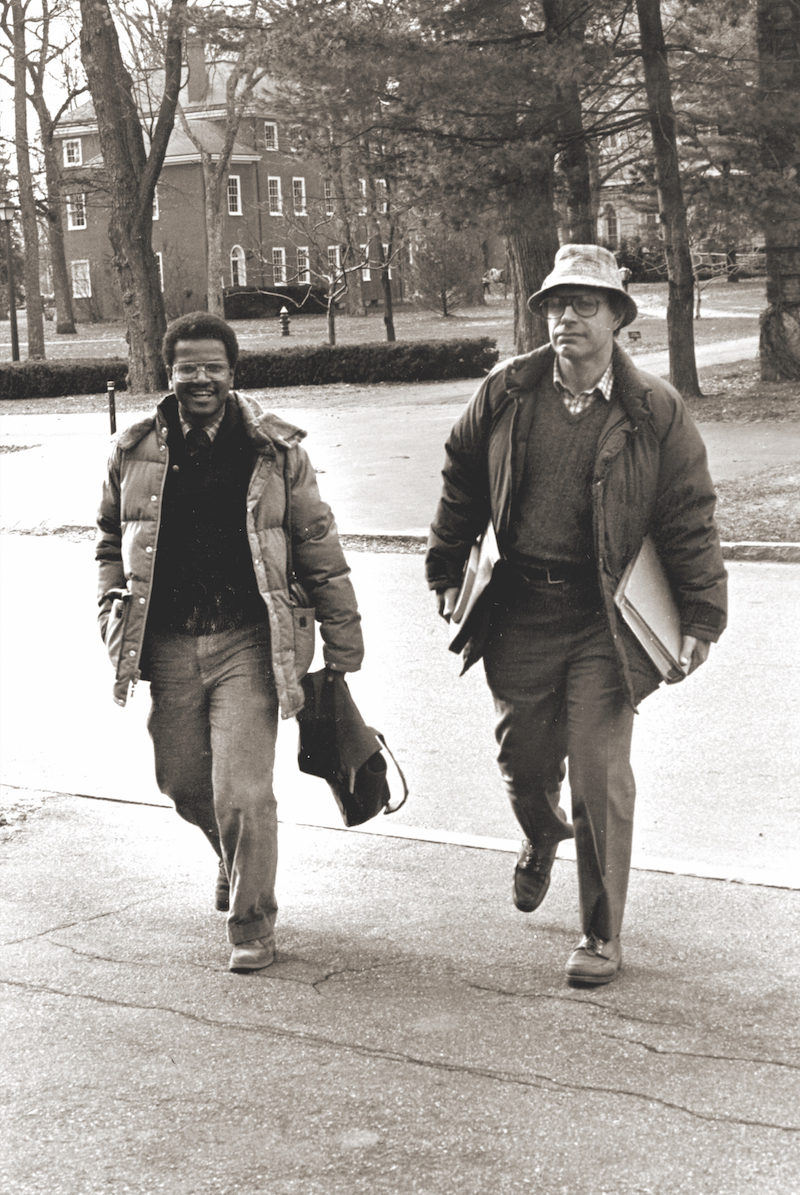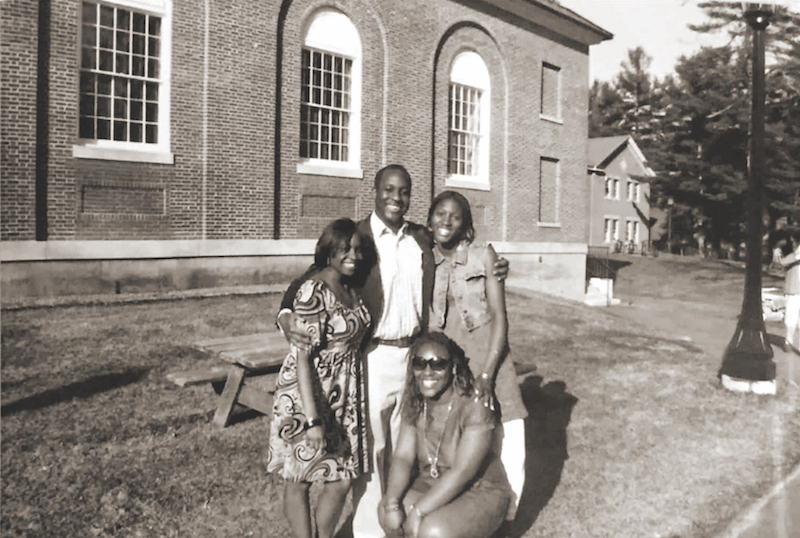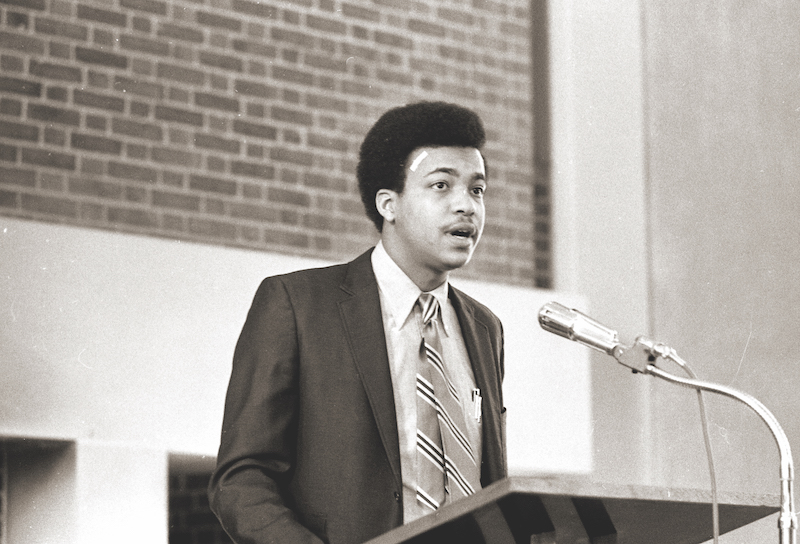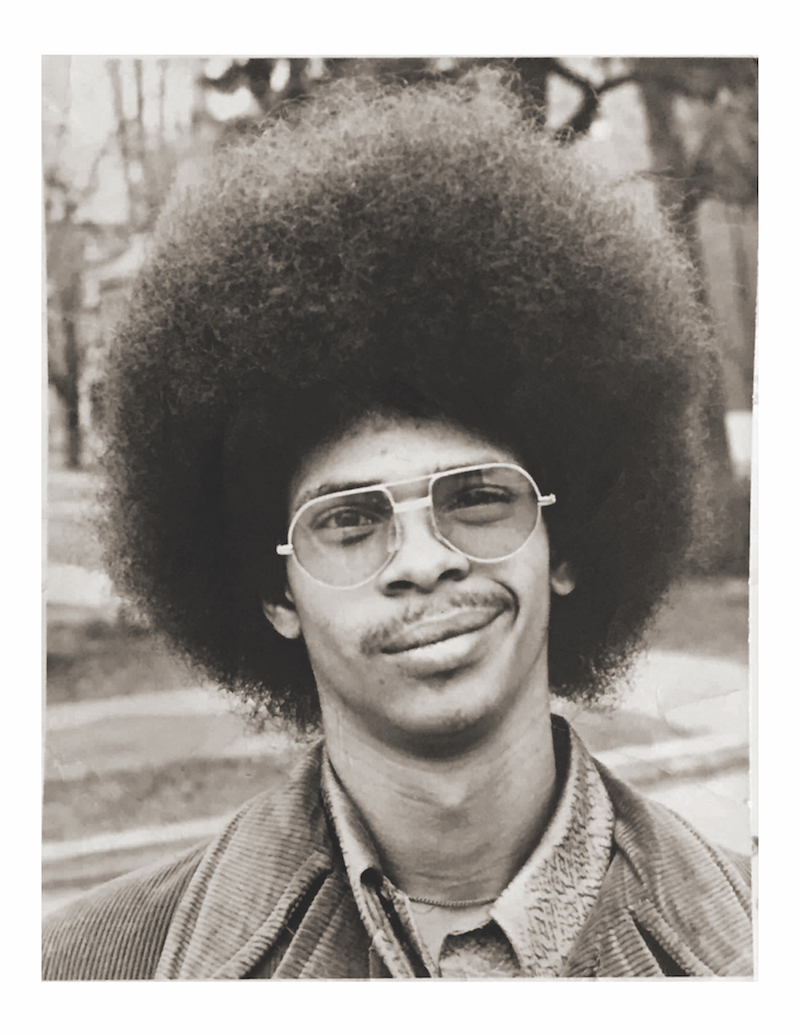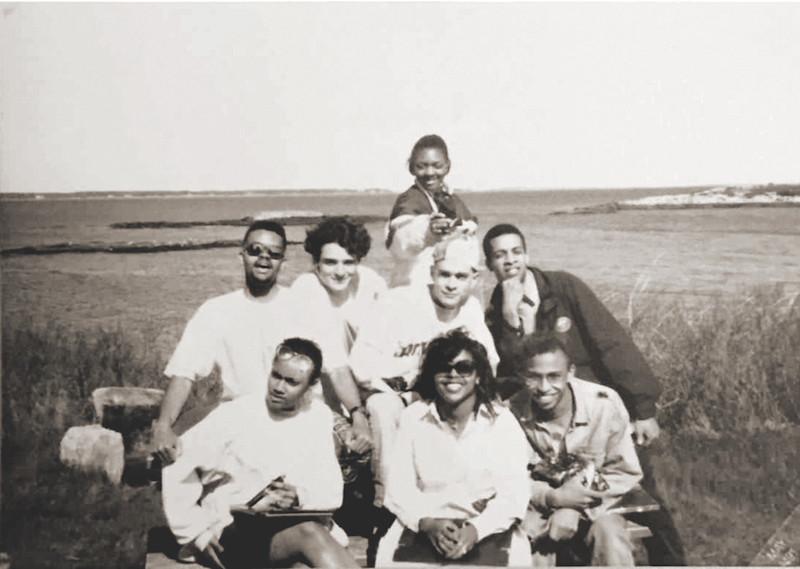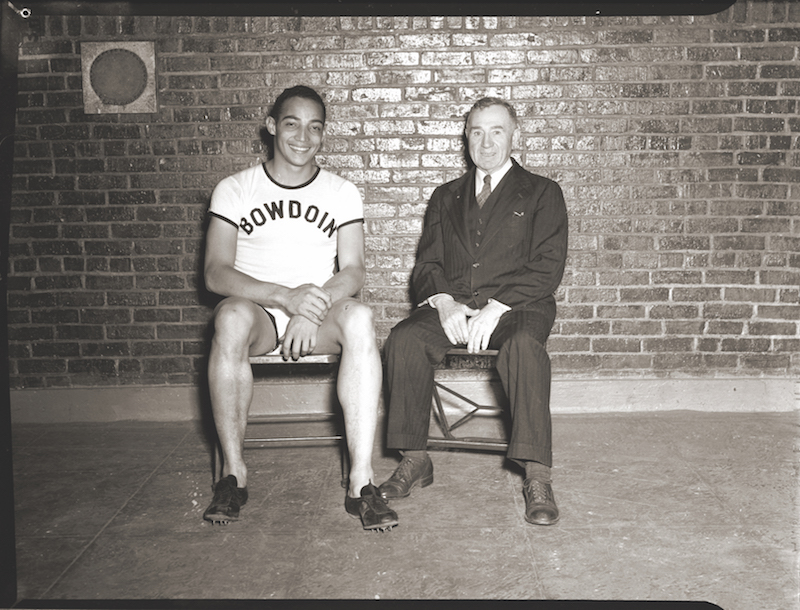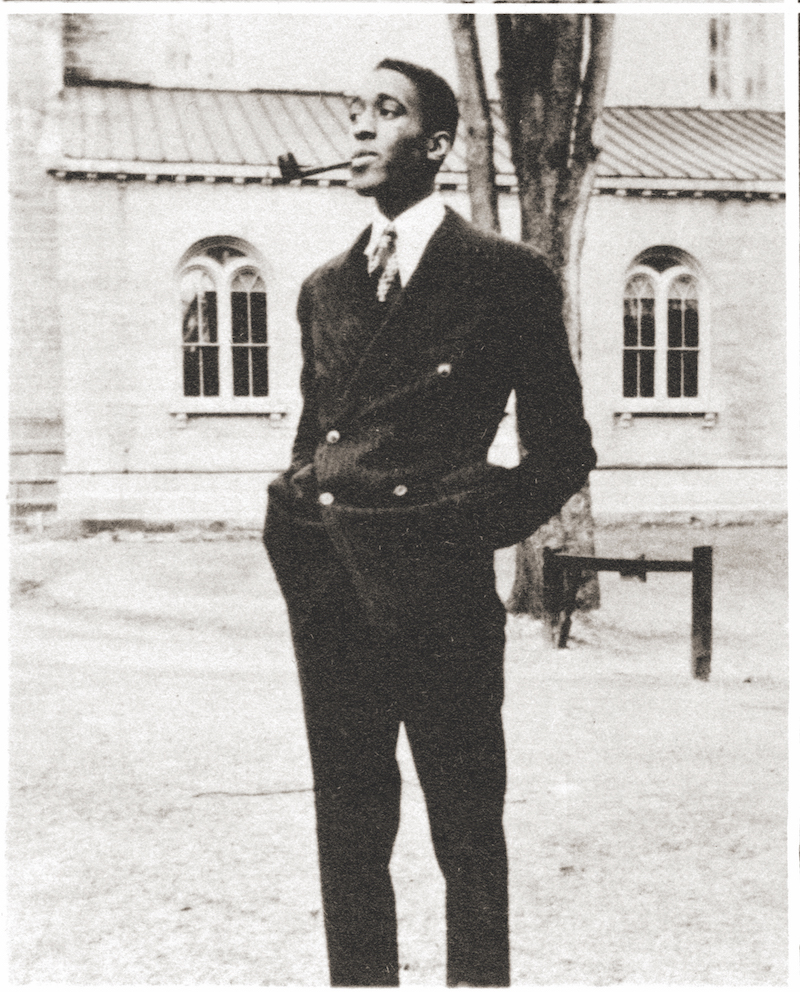AF/AM/50
By Ray Black for Bowdoin MagazineThe window opened on the story of a black community at Bowdoin much earlier than 1969—John Brown Russwurm matriculated in 1822—but it is these fifty years that have shown the most determined change and growth. Progress has not always been smooth, as the commemorative exhibition curated by Lucia Ryan ’19, Tension/Tenacity, shows us clearly and poignantly. Today—with a vibrant Black Students Union, a sense of community and history made beautifully visible on the walls of the Russwurm house, the strength of our Africana Studies Program, and a story that continues to unfold—we celebrate five decades of occasional strife, ongoing persistence, and impressive success.
“Black students, or at least many black students, come to a white college and find much of the same thing: a history which traces back from the United States through Europe with perhaps a flitting mention of Egypt. He well might ask: Where am I in that story?”
——SUBCOMMITTEE OF THE CURRICULUM AND EDUCATIONAL POLICY COMMITTEE ON THE BLACK CURRICULUM, COMMITTEE FOR AFRO-AMERICAN STUDIES PROPOSAL, MAY 1969
The walls of the newly refurbished John Brown Russwurm African American Center feature artworks by black artists and photos depicting black life at Bowdoin going back to around 1910.
“Do you hear that sound?” Jhadha King ’20 asked as she walked across the big room upstairs in the John Brown Russwurm African American Center, also known as Russwurm House. King, an Africana studies minor, vice president of the newly renamed Black Student Union (BSU), and house resident, said excitedly, “That’s a window opening!”
Russwurm was renovated over the summer, and along with windows that now open, it is filled with art and photographs of people who have created the black experience at Bowdoin; being there immerses visitors and residents in that history and community. The refurbishing is one of the many ways the College is recognizing and celebrating AF/AM/50 this year. Fifty years ago, very important windows opened—the establishment of a black student organization, an Africana studies department, and the Russwurm Center itself—but in the years since then, they have also sometimes stuck. What was then called the Afro-American Studies Program began in 1969 with a dedicated director and courses taught by faculty members from a variety of departments around campus. Africana studies today is a freestanding department with four dedicated tenure track faculty. As the College celebrates fifty years of Africana Studies, the African American Society, and the John Brown Russwurm African American Center, the development of these initiatives, from hopes to committees to programs to national prominence, is a story of struggle and progress, much like the story of African Americans in the United States.
THE DREAM AND THE HOPE
The original seeds for an Afro-American studies program at Bowdoin were planted with the matriculation of John Brown Russwurm in 1822. Another seed was planted when Bowdoin hosted a first-of-its-kind exhibition of black images in Maine, The Portrayal of the Negro in American Painting. The Museum had originally planned to display the exhibit in May and June of 1964 but extended it because Portrayal proved to be extremely popular. One of the more than 20,000 visitors was the Rev. Dr. Martin Luther King Jr. during his visit to Bowdoin that year. However, a larger impression than King’s visit and speech may have been made by noted civil rights organizer and King adviser Bayard Rustin. After Rustin spoke on campus, he went to Moulton Union with about one hundred students, talking with them until nearly three in the morning. Late-night discussions about African American life did not end with Rustin.
The first director of the Afro-American Studies Program, John Walter, would continue discussion that began in his class in Moulton Union, occupying the back booths in what he called, undoubtedly with full irony, “the back of the bus.” Half a century later, in Brian Purnell’s Africana Studies 101 class, Justin Pearson ’17 said the “lived experiences and history made sense to me.” The classroom’s challenging conversations often extended into the early morning, when Pearson and other African American students engaged with the understanding that “the weights of the Bowdoin experience do not weigh on everyone’s shoulders the same.”
As an African American professor, Purnell believes his vocation—he sometimes uses the term “ministry”—flows from the mentorship and advice he received from the black studies program and black faculty of his own education. This translates from classroom lessons and individual advising of students on courses and majors into existential questions such as “How do I apply this to who I am and who I want to be?” Black studies provides mentorship and scholarship for all students, but for black students in particular.
The success of the 1964 Portrayal exhibit, along with its notoriety, played an influential role in Bowdoin’s commitment to increase its black student population. In spring 1969, the Afro-American Society presented Black Arts Week, which featured a production of Robert Johnson ’71’s play, Coffee and Sour Cream. That first Black Arts Week also featured Leroi Jones (Amiri Baraka) and the film Nothing But a Man, starring Ivan Dixon and Abbey Lincoln. In May, a proposal passed the faculty to create the Committee for Afro-American Studies (CAAS), whose mission was to develop more courses “that dealt with the black experience” in the upcoming academic year. CAAS provided one way for Bowdoin to meet “the educational needs of the disadvantaged black population,” by creating a program and a major in “Afro-American studies,” staffed by black faculty who were permanent, or temporary, even if it meant bringing them to campus through a faculty exchange.
There was also a proposal calling for an Afro-American cultural center to serve as a location for “the cultural, intellectual, and social activities of black students,” with a library of books, newspapers, journals, records, and films, and a conference room and social center, as well as resident rooms. Virgil Logan Jr. ’69 led one of four student forums in fall 1968 that discussed “The New Role of Black Students.” Logan explained that, in addition to a “source of education to whites,” black students would be “a questioning source to help the College change its values and image...allowing the institution to reexamine itself and let its own racism surface.” The result, he argued, would be a more responsive and relevant institution.
“We wish to plead our own cause. Too long have others spoken for us.”
——FREEDOM’S JOURNAL, JOHN BROWN RUSSWURM, CLASS OF 1826
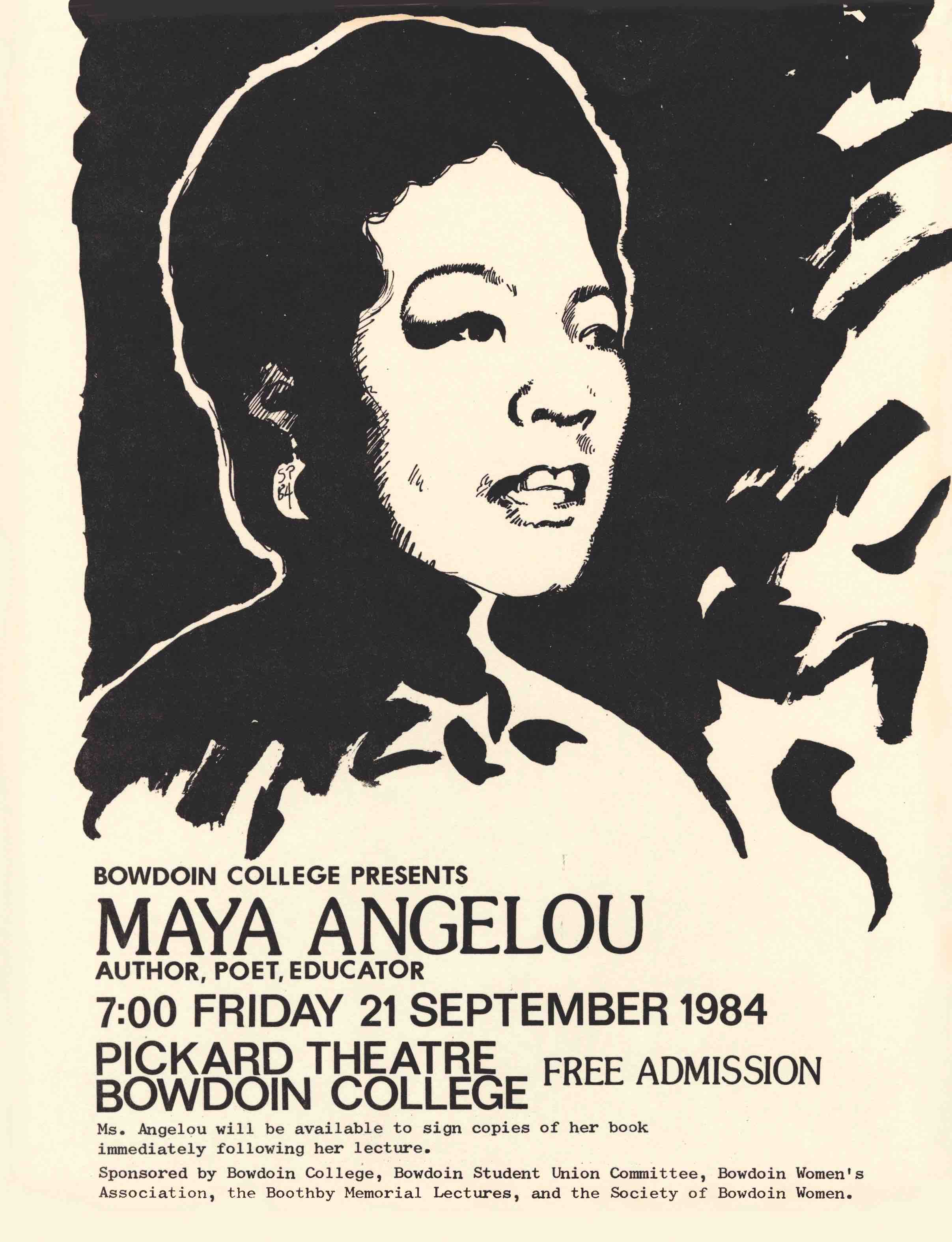
Johnson recalls that, when he arrived at Bowdoin in 1967, Logan and the Bowdoin Undergraduate Civil Rights Organization (BUCRO) paved the way for the founding of Africana studies, but not without protests. Johnson recalled a meeting in 1968 where the administration explained why Bowdoin could not afford to have eighty-five black students by 1970. The students expressed their displeasure and left the meeting. Later, Johnson said, the black students marched from Moulton Union to the president’s office. Each student had a brick in his hand, and they stacked them in a pyramid with a note left on the top that read, “No more water, but fire next time.” The students then had a more productive meeting with the administration, he said.
During that tumultuous time, Johnson said, black students like him “were coming from the inner cities of America, and we were all angry at what was happening.” But, he recalls, “the administration was open. They supported us; they listened to us.”
In June 1969, under the headline “More Blacks Coming,” the Orient reported twenty-three incoming black freshmen, which would bring the black student body up to forty-three. The hope was that CAAS could work quickly enough that those entering the College in the fall of 1969 could graduate with an Afro-American studies major degree if they chose to. A year earlier, in 1968, Bowdoin students had only two options for courses about black people. The rapid growth from an idea in the early 1960s to a program with seventeen courses in 1972–1973 demonstrated Bowdoin’s commitment.
Randy Stakeman arrived at Bowdoin in 1978 as part of the history department faculty. He observed that, in the push for diversity, those students are not always prepared for the “overwhelming white community” of Bowdoin or Maine. The African American Society and academic program “made up...[and] compen-sated” for this adjustment before there were dedicated student affairs staff. After Walter’s departure, Stakeman said that it was difficult to find a new director and that the search for a director had to be changed from seeking a senior professor to finding two junior scholars. In this manner, he said, the College could “grow our own.” This strategy would prove successful, ultimately if not initially. In 1980, anthropologist Lynn Bolles was hired as director and helped the program provide regular course offerings. After eight years as director, she left to head the women’s studies program at the University of Maryland.
After Bolles’s departure, Stakeman was appointed temporary and then permanent director. As the program embarked on a required self-study, Stakeman and the com-mittee found reason to change focus. The transformation from Afro-American or black studies to Africana studies was a move from the original intent, to help a disadvantaged community, to an emphasis on “the continuity of African cultures throughout the diaspora.” This meant the program could embrace “various black experiences,” because the descendants of the African diaspora “share a common origin, experience, and struggle.” When he decided to retire in 2006 after seventeen years, a review of the Africana Studies Program recommended replacing Stakeman with five people. The five were a history professor (Stakeman’s original department), a director, and three dedicated Africana studies tenure-track faculty. Stakeman said the financial commitment to hire dedicated faculty was “a turning point almost forty years after the program started.”
“The condition of the Center is not reflective of the time, money, and effort spent by the Afro-American Society and the Afro-American Studies Program to revitalize a national historical landmark which represents a crucial part of Afro-American History.”
——AMONG A LIST OF FORMAL GRIEVANCES SHARED BY THE AFRO-AMERICAN SOCIETY AND STUDENTS FOR THE REAPPOINTMENT OF DR. WALTER, SEPTEMBER 24, 1979
A HOUSE BECAME A HOME
For the Africana Studies Program and its students, the Russwurm house was a home, a place where they worked, lived, and found the safety and security of black culture. It held classes and events, and housed residents and, initially, department offices. When it was home to the program itself, along with classes, student organizations, and students, Stakeman said the Russwurm house was like “night and day.” Classes and “all the academic processes” would happen until five, unless there was a speaker or event—and after five o’clock, the students would take over. During this time (and some say still), the Russwurm house had the reputation for the best parties on campus.
That the Russwurm house was such a home is largely credited to Harriet Richards. While she worked at Bowdoin as an administrator for the program, Richards earned her own bachelor’s degree in 1992. Stakeman said Richards made “a good connection” between the students and faculty. She helped students with coursework, as she was familiar with the faculty, both as a member of their staff and as a student. She often prepared students for tests and tutored them on assignments. In addition, Richards often hired students to work in the Africana Studies Program. She was well known to offer encouragement, sometimes in the form of chicken soup. For many, Richards was venerated not just as a mother figure, but as “the secret seasoning” for a long Bowdoin winter.
Richards’s passing was memorialized by alumni and colleagues, who called her “a person who possessed courage, warmth, and spitfire in equal measure.” As “one of the biggest cheerleaders for students of color,” she was known as the “fiercely courageous intellectual force” by those who referred to her with the honorific “Mama Harriet.” They recalled how she was “advisor, confidante, and surrogate mother to many,” one who was a “rock” and helped students get through “non-smiling moments.” Her own smile, along with her dedication and influence, were honored with a plaque in the Russwurm house during the fiftieth anniversary celebration.
Another key part of the house, the Russwurm library, had the hallmarks of being well used and had become “totally disorganized” by the time professor Tess Chakkalakal arrived in 2008. She hired Robert Flores ’12, an English major and Africana studies minor, to work with her to organize and catalogue the library, mak-ing the collection accessible again. The library, like the rest of the house, was also an active social space, housing books “with a specific application to Africana studies.”
Justin Pearson ’17, a government and educa-tion studies major, recalled seeing Russwurm’s quote from Freedom’s Journal displayed in the house: “We wish to plead our own cause. Too long have others spoken for us.” As a “proud black American,” Pearson saw himself and other black students contributing to Bowdoin’s academic rigor, as well as being “seen and heard, laughing, dancing, or even praying to Allah, Jesus, or our ancestors.”
Pamela Zabala ’17, now a doctoral student in sociology at Duke University, recalled that the Russwurm house and the Africana Studies Program provided needed spaces for incoming black students, and “fifty years later, these continue to be important spaces for students of all backgrounds to come together, exchange ideas, and share in new experiences,” she said. Lauryn Dove ’21 described Russwurm house as a type of lighthouse for black students, much as the beacons that dot Maine’s shores provide guidance to mariners.
Benjamin Harris, director of Bowdoin’s student center for multicultural life, describes how the BSU and Africana Studies Program work together to produce the Black History Month program in the Russwurm house with significant contributions from other student organizations. Students created a “black scholars night,” a space to “work and socialize” with snacks. Jhadha King ’20 cofounded the Students of Color in Computer Science group.
Renovations to Russwurm house over the past summer include adding a new bathroom on the first level, new floors, fresh paint, and new art and archival photography to the décor. In addition to works by Jacob Lawrence and MacArthur fellow Kerry James Marshall, the walls are adorned with contemporary works by David Driskell H’89, Maurice Evans, and Shanequa Gay, as well as artist and author Justin Bua. The update provided the opportunity to create a living history wall, with pictures of black Bowdoin life going back to around 1910. As part of the renovations, Harris commissioned a new portrait of John Brown Russwurm from artist Eurnice Harris. The building’s facelift, the new Russwurm portrait, and the seminal place the house has in the history of the Africana Studies Program, along with its current role as home for students, centers the house ever more squarely at the heart of black life at Bowdoin.
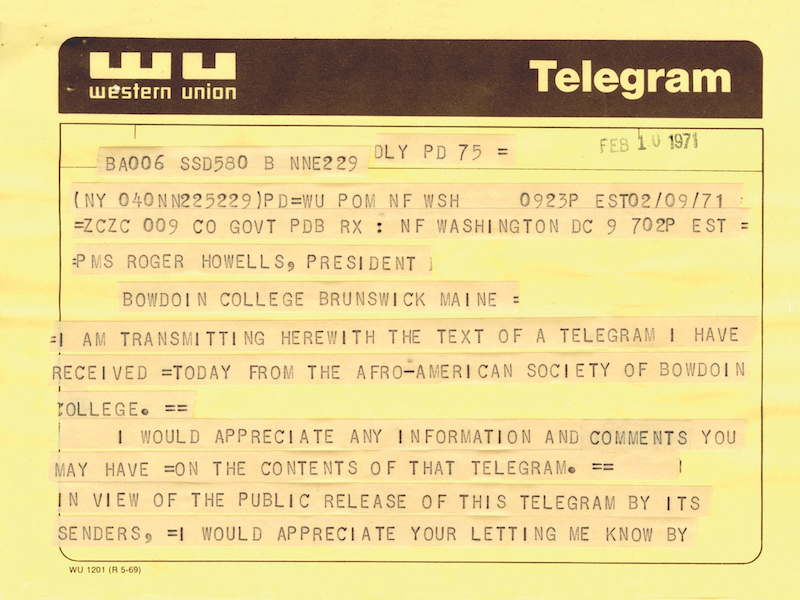
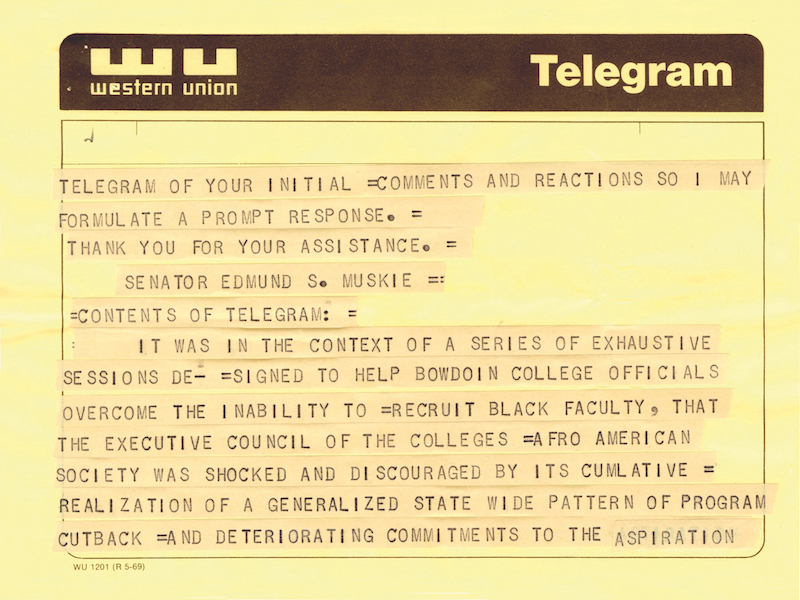
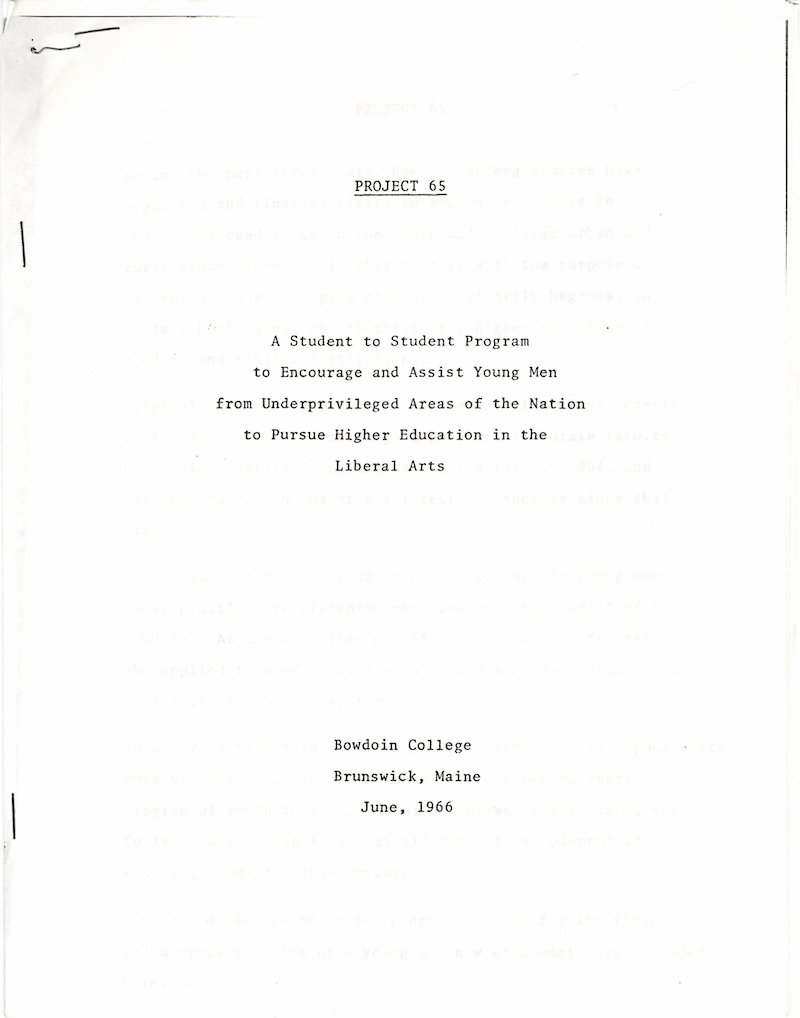
“We’ll put it to you straight. Bowdoin is just not like home or possibly anywhere else you may have been.”
——“WE GET OVER: AFRO-AM AT BOWDOIN COLLEGE,” ADMISSION BROCHURE WRITTEN BY MEMBERS OF THE AFRO-AMERICAN SOCIETY, 1974
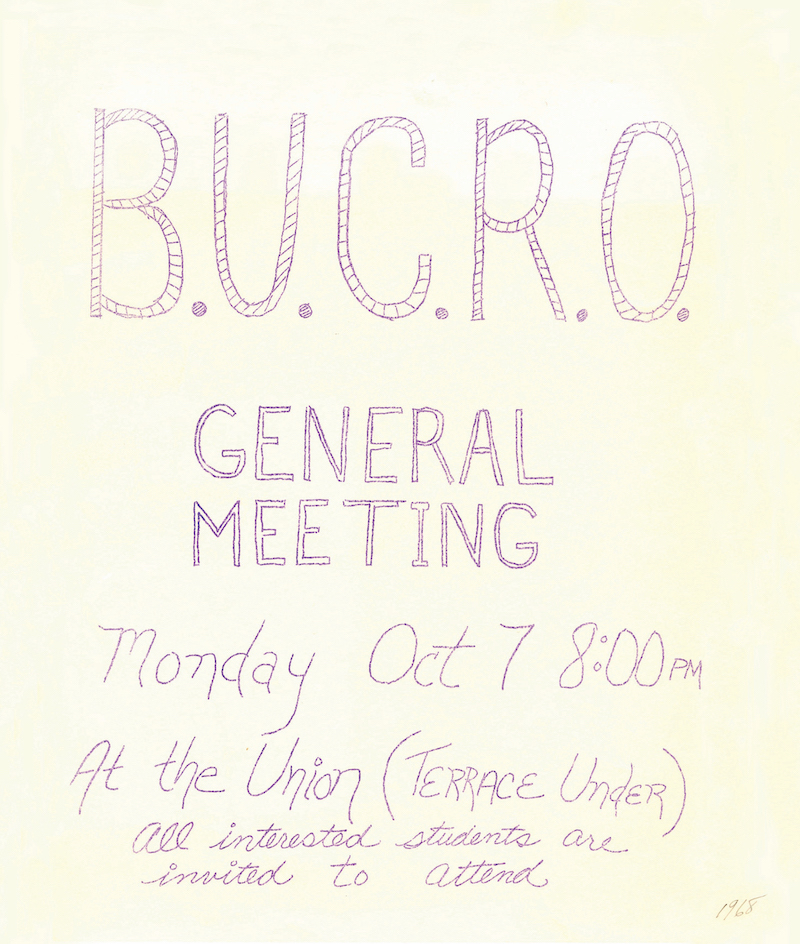
THE VIEW FROM THE AFRICANA STUDIES PROGRAM AND RUSSWURM HOUSE
Chakkalakal arrived at Bowdoin in 2008 as part of a rethinking about and recommitment to Africana studies. She said that support of the administration combined with the freedom to develop a program that balances the needs of students and the rigors of the College have helped Africana studies grow into a premier program. While the department moved out of the Russwurm house, Chakkalakal notes how the faculty work to continue the legacy of the house’s namesake by leading social and intellectual events, reading groups, and speaking series. This rethinking for Chakkalakal concerns Africana studies as “an intellectual project.” The department has a “function and purpose within the academy and beyond.”
In the summer of 2009, Judith Casselberry came to Bowdoin because, she says, “the administrative commitment to the program was really attractive to me. They were looking to build the program and the faculty into the bones of the institution.” One of the changes since her arrival is the Introduction to Africana Studies course, required for all majors and minors and taught by the core faculty. This introduction connects the various student groups to each other as well as to the faculty. In this manner, students and faculty have a connection grounded in the field. Casselberry says having dedicated core faculty meant “a solid intro course,” an intermediate seminar, and a consistent “capstone course.” These elements become “linchpins to coherent curriculum,” where students “can go through a four-year program and [core faculty can] make sure they get everything” they need to graduate. Thus, Africana studies majors and minors “have an educational experience that is really meaningful.”
Brian Purnell knew of Bowdoin from Geoffrey Canada ’74’s 1995 memoir Fist, Stick, Knife, Gun. Canada’s writing inspired Purnell to be a teacher. Purnell says the connection between first learning about Bowdoin from Canada’s book, and now being the Geoffrey Canada Associate Professor of Africana Studies and History, is an inspiration. The position provides him a “compass to try to direct, to ask what is the purpose of [his] scholarship...of [his] teaching...to take the good, take the love and the hope and the optimism and the investment that people...had in their children, in their education, and in their community.” Purnell says he views “Bowdoin as a place where there’s a vibrant black intellectual and cultural life. In his nine years at Bowdoin, most recently as chair of the Africana Studies Program, Purnell is impressed with how “black life and culture develop, expand, and become more diasporic.” Students flow to the program through groups like the Black Student Union, the Caribbean Student Association, and the African Student Union.
In the diverse history of black studies programs, Purnell respects how “black students demanded institutions change, become flexible and dynamic in the way that they deliver their curriculums,” how they hired faculty, and how they positioned “Africa and the diaspora in the overall delivery of education and production of knowledge.”
In Chakkalakal’s view, the Africana studies faculty hired in the past decade have “grown together and learned from each other.” “Being a part of Africana studies at Bowdoin has been one of the best intellectual experiences of my life,” she says. Casselberry appreciates that “the core faculty just so happen to get along really, really well organically.”
For Casselberry, Africana studies is “a holistic enterprise,” with an intellectual side and other understandings “that there are ways of knowing things that are not just in our minds,” which are “legitimate forms of knowledge production.”
“It is not that we haven’t made any progress, or that we have not tried. However, the racism and sexism that were present at the inception of the American college system and which have continued ever since are like a force of gravity...”
——SELF-STUDY OF THE AFRO-AMERICAN STUDIES PROGRAM, PREPARED BY THE COMMITTEE FOR AFRO-AMERICAN STUDIES, SEPTEMBER 14, 1990
A NEW WINDOW ON AFRICANA STUDIES
The newest faculty addition to Africana studies at Bowdoin, Ayodeji Ogunnaike, said he “heard a lot about Russwurm and his legacy” when joining the program. Russwurm and his contemporaries “leveraged their Western educations to bring attention to and fight against the systems of oppression that were designed to subjugate them.” Ogunnaike recalled that, while active in the US abolitionist struggle, Russwurm “was very influential and active in Liberia toward the end of his life.” The Africana Studies Program links the history and study of the African diaspora “much in the same way Russwurm and the contemporary black elite organized their intellectual and political thought and action in the nineteenth century.” Anne and Frank Goodyear created the digital collection “50 Years Later: The Portrayal of the Negro, an American Painting” in 2014. The notes to this collection describe the 1964 exhibit as part of “a multiyear effort to sponsor events related to the Civil Rights Movement.” They are also working with the Russwurm Center on projects like the upcoming African/American: Two Centuries of Portrait, focusing on “works by African American artists of African American subjects,” curated by Lauryn Dove ’21, an Africana studies major with a gender, sexuality, and women’s studies minor.
Dove called the exhibit “a love letter to black people of the past, present, and future.” Two Centuries explores some of the pain that lingers from slavery because the institution “continues to make the earth quake under our feet.” Exploring this legacy, the exhibit is more “about love, song, and sorrow.” Dove says her goal “in curating this exhibit was to make untold stories loud and those that continue to go untold even louder.”
Marieke Van Der Steenhoven, special collections education and outreach librarian, was invited by Purnell to participate in Bowdoin’s fiftieth anniversary celebration. The result is Tension/Tenacity: Africana Studies at 50. Looking into the archives for Van Der Steenhoven means revealing the “sometimes troubling, sometimes funny—the whole spectrum”—of Bowdoin’s his-tory, including occasionally “encountering racist histories that are just kind of engrained into the culture of a college that you can maybe still feel and see the reverberations of today.” The archives tell a history of Africana studies that is “complicated,” “much longer” than fifty years, and “is incredibly rich.” Working with Lucia Ryan ’19, an Africana studies and history major, Van Der Steenhoven located “an incredible trove of admissions brochures that were geared toward black students,” from around 1972 through to the 1990s. Ryan said she discovered “one of the overarching themes is the constant work put into making the program better.”
BOWDOIN’S AFRICANA STUDIES TODAY
Amani Hite ’20 is the current BSU president. She said students changed the name from the African American Society because BSU better reflects the current “beautiful blend of multifac-eted, dynamic, creative, and diverse beings” of the black diaspora, those in the United States and those who more recently immigrated from the Caribbean and African continent. (The BSU is one of several student organizations—including the Africa Alliance, the Muslim Student Alliance, and the Student Organization for Caribbean Awareness—that supports African diaspora students.) Jhadha King, who is vice president of the BSU, credits the recent name change to the organization’s receiving greater recognition on campus and with other student groups across the country, all as part of a larger effort to create a “more immersive community.” While there have been incidents on and off campus, King feels that Bowdoin “really tries to work at [making it better] because, at the end of the day, students are accepted here.” Hite noted that the Class of 2020 is “the most diverse at Bowdoin” ever, and that next year’s class will be even more so. The current experiences of black students, Hite says, are “a testament to progressiveness and hope for the future,” a future that began when Russwurm sat in their seats almost two centuries ago.
TOMORROW, ANOTHER WINDOW WILL OPEN
The Bowdoin College Board of Trustees, with engagement from black students and their allies across campus, acted to create the black studies program a half-century ago. They attempted to “make an honest and sincere effort to increase the enrollment of qualified black students.”
The Africana experience at Bowdoin is celebrated in numbers: fifty years of existence, four tenure-track faculty, increasing enrollment of majors, minors, and students taking courses in the department, the number of events at the Russwurm house, the books in its library, the vinyl records filling its spaces, and the photographs that illustrate its history. But the success of the Russwurm house and the Africana studies department is most reflected in the experience of the students.
In Russwurm, current students enjoy jollof rice, cornbread, and turkey at the BSU potluck, and they “walk with pride in the African Fashion Show,” Hite said. Black students know when Sydney the barber comes to town for a few days, and on the weekends when the beautician visits, appointments fill immediately. As Casselberry tells it, when Harris brought a hairstylist in from Chicago to the Russwurm house for a weekend, Casselberry “booked my appointment!” She said when students found out they asked, “Oh, Professor Casselberry, you’re getting your hair done?” To which she said, “Yes, you know that’s right!”
Even with the success of Africana studies, challenges remain. Chakkalakal notes that some students feel the Russwurm house is only for black students. She emphasizes Africana studies and the Russwurm house are welcoming to the entire Bowdoin community. In fifty years, Chakkalakal hopes students view Africana studies programs and classes just like “government, English, or computer science,” not as “minority discourse.” A half-century from now, she says, Africana studies should be seen as an “equal part of a mainstream intellectual project of a liberal arts education.”
Students who take Africana studies at Bowdoin obtain “the ability to think across different ideas and in depth,” says Casselberry. As an inherently interdisciplinary program, with scholars of various specialties, she says they “have different perspectives and take different approaches...[but] we’re very much on the same page about the importance of Africana studies, not only as a separate program, but the importance of the program in the institution as a whole.” Africana studies gives students a “different way of thinking and processing information that serves them really well no matter what they do in the world.”
During this fiftieth celebration, Justin Pearson ’17 says he hopes that people will “think about the next fifty years,” and with changes past and changes to come, think about “how we are built and how to build others to powerfully plead our own cause.” The Africana experience at Bowdoin, from its intellectual home in Africana studies to its physical home in the Russwurm house to the spiritual home in its student organizations, is an opportunity to be “immersed in the Africana studies community and Africana community,” says King. The future is a wide-open window.
Ray Black is an assistant professor of African American studies in the Department of Ethnic Studies at Colorado State University.
“What I’m most proud of is that we bent the program so much, it was never going to grow straight again. We bent it in the direction of internationalism, we bent it toward student mentorship, and we bent it in the critical thinking direction. Those have become permanent features of the program.”
——PROFESSOR EMERITUS RANDY STAKEMAN, INTERVIEW WITH SPECIAL COLLECTIONS & ARCHIVES, 2019
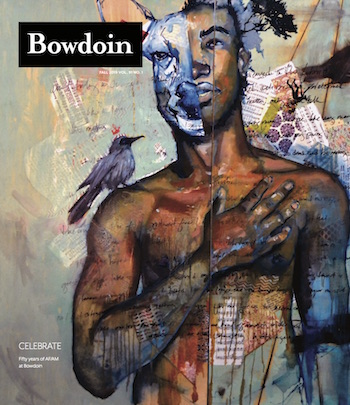
This story first appeared in the Fall 2019 issue of Bowdoin Magazine. Manage your subscription and see other stories from the magazine on the Bowdoin Magazine website.
